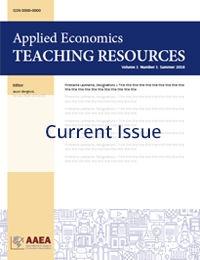Volume 2, Issue 2, March 2020Download PDF
Teaching and Educational Methods
Teaching Information Literacy: A Case Study of the Ripple Effect in Teamwork
Christiane Schroeter, Lindsey Higgins, Hannah Hank, and Caitlin Stevenson
Download PDF
First Published Online: March 29, 2020
DOI: 10.22004/ag.econ.302620
Abstract: The purpose of this study is twofold: (a) describe a teaching case study with college students at a large U.S. university, and (b) highlight how the ripple effect enhances students’ level of information literacy. An “information-literate†student recognizes the need for information and is able to locate, evaluate, and effectively use the needed information. We define the ripple effect as the knowledge acquisition through peer communication among members within a small student group. While interpersonal skills are of increasing importance in the workplace, formal incorporation of information literacy in undergraduate agricultural programs is still developing. Thus, it might be of advantage to rely on constructs of social support and active learning. Employers seek individuals with critical thinking skills and the ability to work and collaborate in teams. As a rapidly increasing portion of entry-level jobs in the agricultural industry are replaced with automation, it has become more important that undergraduate agricultural majors enter the workforce with a competitive edge and employable skills. Results suggest the ripple effect in teamwork aids to enhance the students’ knowledge of agribusiness information literacy concepts."
Keywords: Teamwork, information literacy, Kline’s team player inventory, active learning, team diversity
Facilitating Higher Order Learning: Examining Student Outcomes after a Course Redesign
Anna Josephson, Larry DeBoer, Dave Nelson, and Angelika Zissimopoulos
Download PDF
First Published Online: March 29, 2020
DOI: 10.22004/ag.econ.302618
Abstract: We study student learning outcomes following the redesign of an undergraduate macroeconomics course. Changes were made to focus students’ learning efforts and time in-class on the application and analysis of key concepts. To evaluate changes to student learning outcomes, we use thirteen questions that appeared on final exams both before and after the redesign. The analysis shows that after the redesign student performance on application and analysis questions improved, while performance suffered on memorization and understanding questions. With this paper, we provide a description of our experience and method for others to use in assessing changes in performance after redesigning a large, introductory-level course."
Keywords: Active learning, Bloom’s taxonomy, high-order taxonomy, macroeconomics, undergraduate instruction
Hedging with Futures: An Experiential Learning Game
John Michael Riley
Download PDF | Request Teaching Notes/Supplemental Materials
First Published Online: March 28, 2020
DOI: 10.22004/ag.econ.302619
Abstract: Hedging is often an integral concept in agricultural futures and marketing courses as well as extension marketing workshops. Textbook and chalkboard examples offer students of these courses the ability to understand the concept and learn the mathematics. However, this mode of instruction is less intuitive and does not have a real-world feel. The purpose of this paper is to present an interactive hedging game that was developed to provide students with a more realistic hedging experience that improves the understanding of the mechanics of hedging. Under the premise of an eastern Nebraska corn producer using actual data, a spreadsheet was designed that displays market information to the students who then must make decisions about the number of futures contracts to trade. Pre- and post-game results indicate a positive learning outcome, and students responded favorably when asked if the game enhanced their understanding of hedging."
Keywords: Experiential learning, futures, hedging, teaching
Using Data Analytics and Decision-Making Tools for Agribusiness Education
Matthew S. Elliott and Lisa M. Elliott
Download PDF | Request Teaching Notes/Supplemental Materials
First Published Online: March 27, 2020
DOI: 10.22004/ag.econ.302621
Abstract: The agriculture sector has entered a new era wherein every stage of the supply chain involves gathering an increasing amount of data. Most of these data are generated in real-time and require rapid analysis that can support optimal decision making for agribusinesses to remain competitive. Consequently, employers desire that students gain data analysis skills in agribusiness classes to best inform optimal decision making. This paper discusses how data analytics have been incorporated into an agribusiness management course."
Keywords: Agribusiness, data analytics
Personalizing Online Classes: The Use of Evaluation and Participation Tools
Luis Pena-Lavano
Download PDF
First Published Online: March 25, 2020
DOI: 10.22004/ag.econ.302622
Abstract: Self-directed online learning is challenging for many students. Limitations in interaction with the instructor, difficulty in focusing in the major messages of the course, and not active encouragement in the video lectures are common constraints. In this article, I present a case study in which I implemented in my classes two methods to overcome these limitations: the use of online evaluation tools and in-person review sessions. Utilizing regression modeling and the qualitative information of the class evaluations, I argue that the use of these methods has presented positive impact in the learning process of the students and improved the interaction between instructor and student."
Keywords: Online, teaching, evaluation, active learning, learning interaction
Teaching and Education Commentaries
The Do Now: A Simple, but Effective Active Learning Strategy
LaPorchia A. Collins
Download PDF | Request Teaching Notes/Supplemental Materials
First Published Online: December 8, 2020
DOI: 10.22004/ag.econ.302623
Abstract: Students often have difficulty applying concepts discussed in lectures. Using practical guidance that allows for flexibility in implementation, I highlight the Do Now as a short, practice exercise that promotes just-in-time instruction. My approach stresses application of course concepts to improve student self-efficacy and performance. A supplemental teaching note provides additional guidance on implementation."
Keywords: Active learning, formative assessment, interactive lecture, self-efficacy


